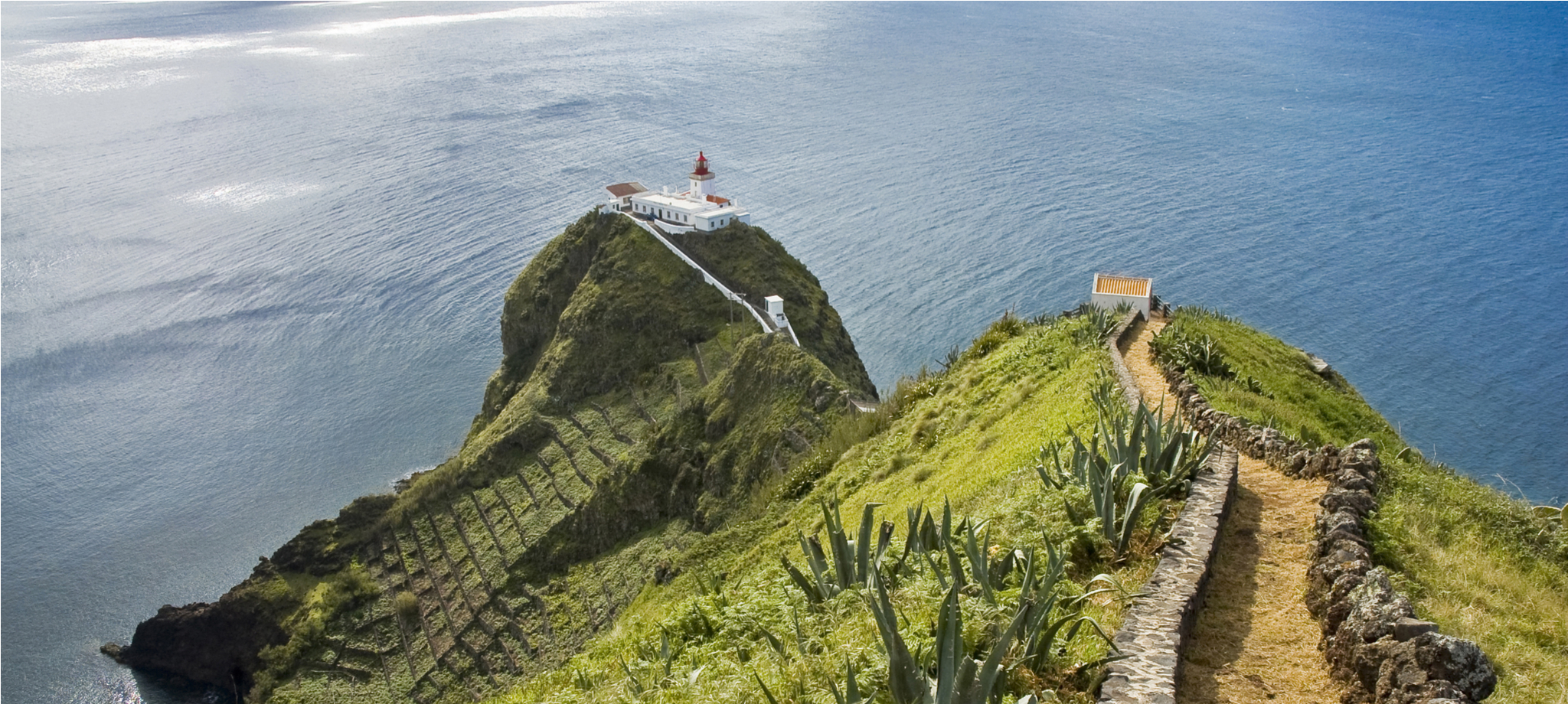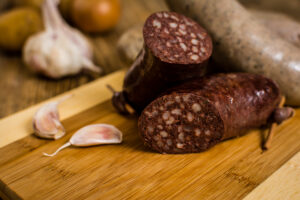Typical food and the best restaurants on Pico Island
Rooted in the island’s natural bounty—whether from the land or sea—Pico’s gastronomy is a delicious blend of traditional Azorean cuisine, hearty dishes, and unique local ingredients.
What eat on Pico: 7 traditional dishes
The cuisine of Pico is robust and flavorful, offering a variety of meat, seafood, and vegetable dishes that reflect the island’s agrarian roots and proximity to the Atlantic Ocean.
1. Torresmos de Porco
Small, browned pork rashers often served crispy, these pork bites are rich in flavor and perfect for meat lovers.
2. Morcela (blood sausage)
This Azorean delicacy, often spiced and served with vegetables or yams, is a favorite on the island.
3. Linguiça com inhames
A dish featuring Portuguese sausage paired with yams, linguiça com inhames is a hearty and flavorful meal that showcases the island’s agricultural produce.
4. Molha de carne
A rich meat stew typically served with bread to soak up the flavorful broth. It’s a popular dish during festivals and gatherings.
5. Caldo de peixe (fish soup)
This traditional fish soup is a comforting dish that features a rich broth made from local fish, seasoned with herbs and spices.
6. Polvo guisado em vinho (octopus stewed in wine)
Octopus is slow-cooked in local wine, creating a tender and flavorful dish that’s a must-try for seafood lovers.
7. Shellfish
Pico offers a variety of shellfish, including lobster, deep-water crabs, and cavacos (a type of small lobster), all known for their freshness and distinctive flavor. These shellfish are often enjoyed with a simple seasoning that lets the natural flavors shine.
Through our tour packages you can taste and enjoy this firsthand! Check them out!
Best restaurants on Pico Island
To experience the best of Pico’s traditional cuisine, here are some of the top restaurants where you can savor these iconic dishes:
-
Cella Bar (Madalena)
Cella Bar is a must-visit spot in Madalena, offering stunning ocean views alongside a modern, chic atmosphere. The menu features fresh seafood, local meats, and traditional dishes like octopus stewed in wine. Pair your meal with a selection of Pico wines for an unforgettable dining experience.
-
Ancoradouro (Madalena)
Located near the harbor in Madalena, Ancoradouro is known for its authentic Azorean dishes, including fish stews and seafood specialties. This restaurant is a great place to enjoy fresh shellfish like cavacos and deep-water crabs, perfectly accompanied by local wine.
-
O Montanha (São Roque)
For a rustic and authentic dining experience, O Montanha in São Roque serves hearty, traditional Azorean dishes such as linguiça with yams and molha de carne. This local favorite is known for its generous portions and warm, welcoming atmosphere.
-
A Tasca O Petisca (Lajes do Pico)
This cozy family-run restaurant in Lajes do Pico offers a menu full of Pico specialties like fish soup and torresmos de porco. The intimate setting and homemade dishes make it a wonderful place to enjoy a traditional meal.
-
Adega Açoriana (São João)
Adega Açoriana, located in São João, is a hidden gem that serves traditional dishes with a modern twist. Using fresh, local ingredients, this restaurant offers a seasonal menu featuring Pico’s finest produce, seafood, and cheeses.
Cheese
Pico Island’s cheese is another highlight of its gastronomy.
- Fresh white cheese – A soft and mild cheese often served as an appetizer. It pairs perfectly with local bread or as part of a cheese platter.
- Cheese from São João – Known for its yellow rind and soft, creamy interior, this cow’s milk cheese has an intense aroma and flavor, making it a favorite on the island.
Traditional sweets and desserts
Pico’s sweet treats are closely tied to the island’s religious festivals, particularly the Holy Ghost Festivals, and reflect the island’s rich cultural traditions.
- Massa sovada – A sweet bread that is soft, fluffy, and slightly sweet, often enjoyed during festive occasions.
- Rosquilhas, vesperas, and arroz doce – These traditional pastries and rice pudding are common during celebrations and make a delightful addition to any meal.
- Carnival sweets – During Carnival, locals enjoy filhoses (fried dough treats), coscorões (crispy pastries), and sonhos (light, airy fried dough balls often dusted with sugar).
For those who enjoy spirits, Pico offers local brandies made from figs and other fruits, produced using traditional copper stills. Angelica, a sweet liqueur, is also popular and serves as a delightful digestif after a hearty meal.
Pico Island wine: the “verdelho”
Pico’s volcanic soil, sunny climate, and unique winemaking traditions have made the island’s wine world-renowned. The vineyards, protected by stone walls made from rough lava, produce grapes that are packed with flavor. Here are the notable wines of Pico:
- Verdelho – This dry white wine, with an alcohol content of 15 to 17 percent, is produced from grapes grown in the island’s lava soils. With its honeyed sweetness, Verdelho has been a favorite wine for centuries and was even served at the Russian Court in the 19th century.
- Fresh, fruity wines – Pico’s vineyards also produce light, fresh, and fruity wines, perfect to pair with seafood or fish dishes.
- Vinho de cheiro – This red wine, known for its distinctive aroma, is a staple at local festivals and feasts. It is enjoyed across the island, often served alongside traditional meals.
The orchard island: Pico’s Island fruit
Pico is often called the “Orchard Island” due to its ideal fruit farming conditions. With lava-rich soil and a sunny, dry climate, the island produces a variety of fruits that are known for their sweetness and flavor.
- Figs – Figs are perhaps the most iconic fruit of Pico, with their ruby-red interior and sweet flavor. They are a common sight on the island and are often used in desserts or eaten fresh.
- Apples, pears, and peaches – These fruits flourish on the island, growing in abundance in Pico’s fertile soils.
- Plums and oranges – Along with apples and pears, Pico also grows delicious plums and oranges, adding to the island’s diverse fruit production.
The fresh produce from Pico is often taken to nearby Faial Island, particularly to Horta, where it is sold at local markets. Pico’s fruits, particularly figs, are enjoyed by locals and visitors alike for their exceptional taste.
There’s plenty to taste, but there’s also plenty of places and activities to on the island! Explore what to do and see!




